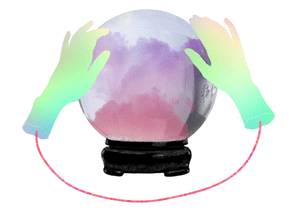Wouldn’t it be nice to see into the future?
We’d all make perfect decisions. Our companies would always be in the black. All our employees and investors and managers would be genius angels working in tandem for success. We’d all be totally happy.
It would also make things a little boring if we knew everything that was going to happen. Part of the fun of entrepreneurship is venturing into the unknown. 
But there is one precognition that could shake things up for the better...
Accurate revenue forecasting is a game changer. Especially when done using deep learning technology.
When we leverage this growing technology, we’re able to better empower our GTM teams, and allow them to spend more time working on other tasks. Letting deep learning models do the driving can free up time and energy. This new productivity can help your company move faster.
This is important for both established and new companies alike. Let's get into it.
Using Revenue Forecasting Models can be your main driver for business health
The ability to accurately forecast revenues has obvious benefits for your finance team.
Your CFO can use these forecasts for budgeting, investor relations, and ROI analysis to inform investment spending.
But this is what I call the boring side of forecasting. 
What if you could use revenue forecasts to actually boost your topline?
Forecasting revenue at the customer account level could be the driving force behind your sales teams’ day-to-day tasks.
Revenue forecasting allows you to be proactive rather than reactive.
If you see a dip coming up next quarter, you can remedy it beforehand!
You don’t have to wait until afterward (when your shareholders perhaps aren’t the happiest).
Effectively using insights from forecasting could help sales reps prioritize their efforts and ultimately increase revenue attainment beyond what they can do now. Like I said, game changer!
Forecasting is inherently a “predictive” technique.
Knowing the likelihood that a future event will happen becomes a superpower for a business.
What is a forecasting model? What do you need to use them to grow revenue?
Forecasting models take all shapes and sizes, but in a rough sense, they typically rely on a mix of quantitative historical data and qualitative domain expertise.
The more elements of the real world you can incorporate into your model (e.g. historical revenues, seasonal changes, product/service usage, sales interactions, etc.), the better chance your model has of performing to your standards. 
In this case, more is more. Giving models more information, just like us, allows them to make better predictions. They can make more accurate predictions because they have access to the full picture.
Ok, so revenue forecasting is powerful. Got it.
This can be a great exercise in breaking down data siloes as well. To be trained properly, your model will need inputs from across your business, not just sales.
How can you get started? And what’s the best way to approach it? Enter deep learning.
What are deep learning techniques?
Deep learning is a technique that uses mathematical algorithms to mimic the way our human brains learn.
Just how babies learn how to do everything through exposure to stimuli and practicing, this is how we train machine learning models.
If you’ve ever played with them (or maybe had one of your own) you know that everything they do is a learning experience. Whether grabbing toys with their hands or eating something sour, everything they do builds their knowledge of the world.
Our brains are made of a network of neural connections, so it’s no surprise we call these deep learning algorithms “artificial neural networks” (ANNs). Many powerful revenue forecasting models use ANNs. 
Like our brains “learn” from our experience of the world, ANNs are trained with large amounts of data gathered from various digital sources (e.g. billing systems, CRM data, product analytics, etc.).
When we use deep learning techniques, our capabilities grow with the amount of data we have. Whereas, older learning methods eventually stagnate, even as data increases.
So, the big take-a-away: you need data! And lots of it.
So now we need to figure out the other parts of the puzzle. Like, when is deep learning right for you? And when is it perhaps not the best? Like anything, it’s always better to figure out if it’s a fit before diving into spending money and time on building it.
When deep learning might be a great fit for your company
Here are three reasons deep learning might work for your business:
1. If your organization captures hundreds of data inputs…
These are called features. This is the first sign that you should consider deep learning.
Having a wide breadth of inputs is key to building a successful deep learning model.
Deep learning works well on high-dimensional data that has a mix of dynamic (frequently changing) and static (infrequently changing) inputs.
So if your company is already proficient at capturing high-value and varied features, it might be in your best interest to implement deep learning models.
2. If you need to create a learning algorithm quickly…
Deep learning doesn’t require a lot of domain knowledge.With traditional machine learning, your business analysts and data scientists spend weeks, if not months, establishing a map between business knowledge and data signals (a process called feature engineering).

With deep learning, your data engineer simply trains your model on all your data without having to go through an input selection process. This saves you time and effort.
3. If your company is a fast mover in terms of business evolution…
Deep learning is an ever-evolving space, so researchers are continually developing new techniques that afford us more model complexity.
We get access to sophisticated techniques like transfer learning, multi-task learning, auto-encoding, etc. The net benefit is that these techniques can be used to develop high performing models.
You can bring better answers to your team faster, while being part of a space that is changing business for the better.
When deep learning might not be the best fit for your company
And then here are a few reasons deep learning might not be the best fit for your company:
1. If you don’t have massive data sets…
For example, if you sell products with yearly subscriptions (ARR), you might not have enough historical data points for effective deep model training.
It can also be an issue if the data you do collect isn’t varied. Perhaps you’ve only collected static features. You need both static and dynamic inputs to build a successful model.
If a customer has been with you for three years, you only have three revenue numbers to use to find a reliable pattern – probably not enough for a deep learning model to learn much from.
2. If your data doesn’t contain any patterns…
Deep learning only works if a pattern can be established from the data to begin with, and this is a binary outcome.
Your data either has a pattern or not with deep learning. With traditional models, on the other hand, you can insert domain knowledge and mathematical assumptions into the data to overcome this lack of signal challenge. 
It's well known that your ability to retain a customer account depends on your relationship with your champion customer contact.
If that champion leaves, that’s a good sign that your revenue for this account is at risk.
With a traditional model, you can use this “domain knowledge” to your advantage and adjust the weight of this factor into your model – not something you can do with deep learning.
So if your retention is much more reliant on these interpersonal relationships rather than data, it might not be right.
3. If your operational teams/leaders require ‘the why’…
Deep learning models are black boxes.
If your deep learning model forecasts that your revenues will triple in the next quarter, you get little insight into “why” that’s the case, which can be frustrating for a business that wants to act on the forecast.
So although deep learning can produce helpful predictions and forecasts, it can be harder to see how it got from point a (features) to point b (predictions), without the team having their own vast knowledge of how deep learning works.
Using Deep Learning Forecasting Models for Revenue Growth
Now that you’ve evaluated whether or not deep learning is even plausible for your business, you can take a serious look at forecasting with it.
If you have an overwhelming amount of data, and your business use case doesn’t have a strong requirement for explanation, then go with deep learning. This scenario is ideal for revenue forecasting.
-1.gif?width=301&height=220&name=giphy%20(3)-1.gif)
Deep learning in forecasting can help you increase your net revenue retention and expand current accounts.
It can help you make predictions that are quantitatively validated and properly customized to each customer.
And of course, better predictions = happier customers
When your team has these predictions, they have an easier time planning for the future, and can allocate their time better to help your customers stay longer and grow with you.
If you have more questions about deep learning or revenue forecasting, drop us a line here. We’d love to chat!





